[practical information] Coffee has a variety of flavor of the key factor, the original is …...
For professional baristas, please follow the coffee workshop (Wechat official account cafe_style)
Coffee extraction is not only to extract the original flavor of coffee intact, but also to adjust the taste according to the preference and personality of the extractor. The interesting thing about coffee extraction is that you can get all kinds of flavors. So, what factors will affect the extraction of coffee?
1
Extraction time and concentration
When extracting coffee, very strong coffee will be extracted at first, and then the color of the extract will change and gradually fade. This is due to a decrease in the amount of coffee ingredients dissolved in coffee. The composition of coffee is different from what we think. It doesn't dissolve the same concentration from beginning to end, but it dissolves a lot at first and then becomes less.
Coffee is a drink that dissolves the ingredients formed in the baking process into water. Therefore, depending on the concentration of coffee ingredients dissolved in water, the taste will also change. In the early stage, the concentration of the extract is high, the aroma and taste are strong, while the later extract is light. In the initial stage, about 20% of the extract has already dissolved about 80% of the coffee. In other words, the initial extract dissolves the most coffee ingredients, so it plays a role in determining the taste and aroma of coffee. In the later stage of the extract, the flavor will be released from the woody components in charge of the coffee bean structure, and more ingredients that determine the consistency and bitterness will be released.
By mixing the initial extract with water, you can get a lighter, softer, better-scented coffee, but the consistency and personality will be weakened. At this time, if an appropriate amount of coffee is added to the coffee extracted in the later period, the bitter taste will become slightly stronger, which can enhance the consistency under the condition of aroma and taste, and become a personalized coffee. The aroma and taste of the coffee extracted in the early and later stages are different. As long as you make good use of this point, you can skillfully adjust the taste according to your personality.
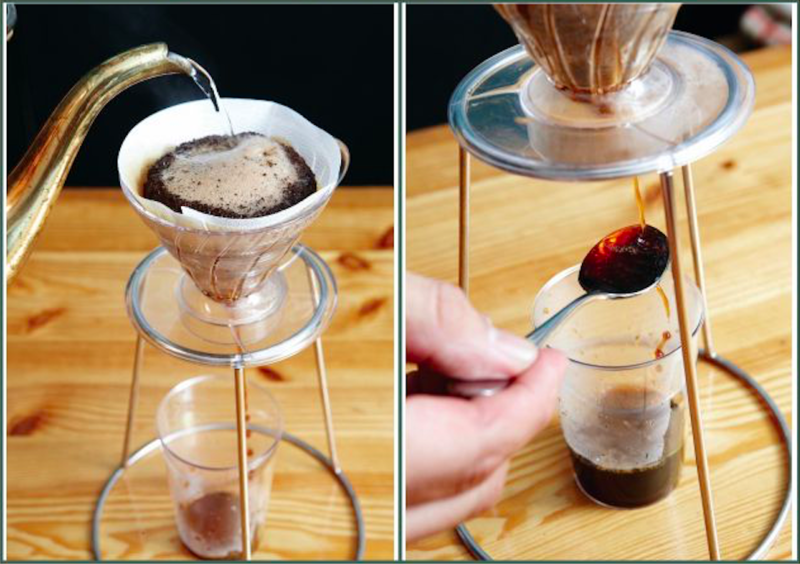
Taste coffee according to different extraction stages
two
Make use of the opportunity of water injection
Since many ingredients that can produce a good taste will be extracted at the initial stage of extraction, only a small amount of water will be injected at the end of steaming to extract the ingredient as much as possible, and then wait for the water in the filter cup to be fully filtered and injected again, it will produce a strong diffusion phenomenon, and extract the coffee which feels very strong.
Compared with the initial stage of extraction, the later stage of extraction is faster, so it suppresses the taste. If more water is injected into the filter cup than at the initial stage of extraction, the extracted product will become dilute because of the faster extraction speed. In other words, if water is added when only some of the extract is filtered out, a lighter extract can be obtained.
However, if you want to use this extraction method, the taste will be different each time from being familiar with the amount of water injected, the number of times of water injection and the time point. Even if you are already very familiar, there will be subtle differences in the taste each time, so it is difficult to make the same coffee every time. There is no problem if it is a personal taste, but if it is used in a coffee shop, it will be very disturbing to have a different taste every time.

Color of coffee extract at each stage (initial stage → later stage)
three
The particle size of coffee
This is related to the area of coffee cells in contact with water. To take a simple example, if you put large particles of crude salt directly into water, you will find that ground salt dissolves faster than coarse salt than if you grind it down and then put it into water. Because of the fine grinding, the surface area in contact with water increases and naturally dissolves quickly.
Coffee is also, if you grind the coffee fine, the surface area will increase, and the area that can dissolve the coffee ingredients after meeting the water will also become more, so you can extract the stronger coffee. On the contrary, the thicker the coffee is ground, the less the surface area and the concentration of the extract.
A tool for determining the size of ground coffee particles: standard analytical sieve (Testing Sieve)
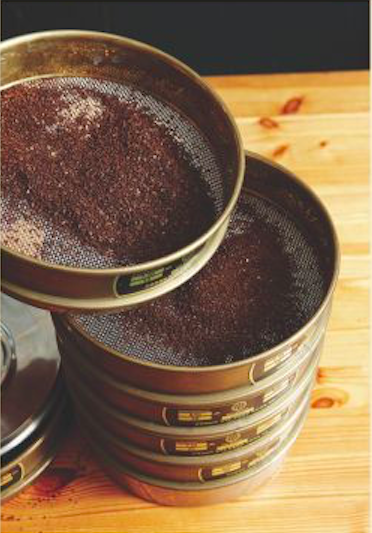
Made of iron mesh, it is usually referred to as the size of mesh when it comes to the thickness of coffee powder.
four
Is the coffee ground as finely as possible?
The finer the coffee is ground, the more easily the holes in the filter paper that are intended to allow water and coffee ingredients to pass through are blocked by coffee particles, and the water becomes difficult to pass through the filter paper. On the other hand, the slower the coffee is extracted, the stronger the miscellaneous smell released by the coffee that has been soaked in water for a long time.
This is why espresso is ground to a very fine size to bring out the greatest aroma and flavor of the coffee. However, if the particles are too small, it is difficult for the water to pass through the filter paper, so it is necessary to apply a pressure of 9 air pressure to let the coffee particles pass quickly and extract the aroma and flavor properly. But in the hand, because there is no pressure to make the extraction faster, so it is necessary to adjust the size of the coffee powder.
Usually, when grinding coffee, the ideal size is that 0.85mm-sized particles account for about 70% of the total. But in fact, in the extraction, it will roughly fall in the size of half a sesame to the size of a sesame. In this range, according to the desired coffee concentration or aroma, to find out the size of the particles that can cook the taste you like.
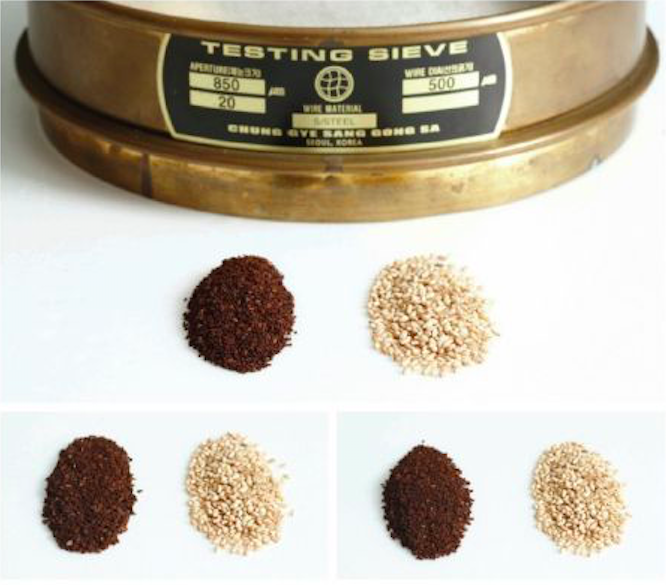
Is it really true that coffee powder is ground as finely as possible?
five
The temperature of water
When extracting coffee, water temperature is also one of the factors to adjust the aroma, taste and concentration of coffee.
Try to put sugar in hot and cold water, and you will find that sugar dissolves quickly in hot water. The same is true of coffee. The hotter the water is, the more aroma and taste of the coffee itself will be dissolved. The aroma and taste will become stronger, and the bitterness will also increase. If the water temperature is relatively low, the aroma, taste and bitterness of the coffee will also weaken.
The best extraction water temperature is 90 ~ 92 °C. If the temperature is higher than this, the ingredients in the coffee (such as caffeine) will change due to the high temperature, become more bitter, and produce a bad smell like tire soot.
However, it is not necessary to think that keeping the water temperature at 90 °C to 92 °C is a rule that must be followed. This is because, if the temperature must be maintained from the beginning of the extraction to the end, the coffee will produce the most good taste while the bad taste of the coffee itself will appear abnormally. So adjust the water temperature of the extraction and extract the coffee you think is delicious.
Adjust the temperature according to the extraction time
The extraction time should also be taken into account when determining the water temperature. Basically, the extraction time is short, the use of high water temperature will be more advantageous; when the extraction time is long, the relatively low water temperature will be better. If the extraction time is short, the bad taste or mixed flavor will be extracted for a short time, so the bad taste will not become stronger if soaked in hot water. However, if the extraction time of coffee becomes longer, the time for brewing miscellaneous flavor becomes more abundant, and as the time goes on, it may make the bitterness and wood taste become too strong. Therefore, we should first take into account everyone's favorite taste and extraction time and other factors before determining the water temperature. According to the extraction time, a variety of changes can be made between 80 °C and 90 °C.
Adjust the temperature according to the material of the hand pot.
In order to adjust the temperature, the material of the hand-punching pot should also be considered. For example, a copper hand punch will cool down soon after it is filled with water because of its good thermal conductivity. Therefore, in the initial stage of extraction, hot water will be used to extract strong coffee ingredients, the aroma and taste are very strong; in the later stage, relatively low water temperature will be used, and the extracted products will be unusually light. Like this, when the strongly extracted part meets the relatively weak part, you can collide with a cup of balanced coffee with good aroma and taste, less bitterness and less miscellaneous taste.
Adjust temperature according to the freshness of coffee
If you inject water into the coffee powder, the water will enter the porous structure of the coffee, pushing the gas inside out. Fresh coffee beans are filled with gases formed during baking, so they can be easily extracted even at low temperatures. And at this time, the oil inside the coffee cell has not yet infiltrated into the porous structure formed during baking, so the extraction will be relatively smooth, so it can be extracted at a relatively low temperature (80 ~ 86 °C).
If the coffee has been kept for a long time, the internal gas has naturally been lost, and the oil has infiltrated into the porous structure, which will make the extraction less smooth, so it is better to use a slightly higher temperature (84C ~ 92C) to extract.
six
The aroma of coffee
Usually, 10g of coffee powder is used to extract a cup of 120ml coffee, and an additional 8g is added for each cup. When coffee is extracted in this case, the proportion of coffee is changed precisely because of the shape of the filter cup. Because the filter cup is funnel-shaped, even if you put an extra 10g of coffee in it, the area (round) that can be spread out will not be twice as large. So even if the amount of coffee is reduced, the appropriate concentration can still be obtained.
The ideal coffee extraction concentration refers to the proportion of coffee brewed from the filter cup (coffee extraction rate) is 18-22% (SCAA standard). According to this standard, if about 50-65 g coffee powder is used in the extraction of 1L coffee, the optimal concentration of 1.15-1.35% can be obtained.
In the extraction of 1L coffee, if only 40g coffee powder is used, and the extraction rate of coffee is between 18-22%, the concentration will be reduced to 0.8-0.95, which will feel lighter. If you grind the coffee particles finer, or extend the extraction time, although the concentration will become higher, but this may also lead to over-extraction, unable to ensure the taste of the coffee. Therefore, in order to get the appropriate coffee concentration, it is necessary to adjust the amount of coffee powder. To extract a cup of 120ml coffee, just use 6-8 grams of coffee powder.
But these are all discussed in the case of coffee granule size 0.85mm as the standard. If the coffee particles are thicker than this, a little more coffee powder must be used because the extraction rate and concentration will decrease. If it is finer than this, the extraction rate and concentration will be higher, so you can use less coffee powder. And if it is a large amount of coffee extraction, in order to avoid over-extraction, you can also slightly reduce the amount of coffee powder.
When applying the ideal values of these standards to coffee extraction, we should not only consider the values, but also take into account various variables, and face our target data with a soft attitude. When making the final evaluation, in addition to taking into account the degree of completion of the value, we must also use the senses to examine, that is to say, it is also very important to have a good perception of coffee. It is important to remember that in many surveys, stronger or lighter coffee will be well received, even if it falls outside the ideal extraction rate.
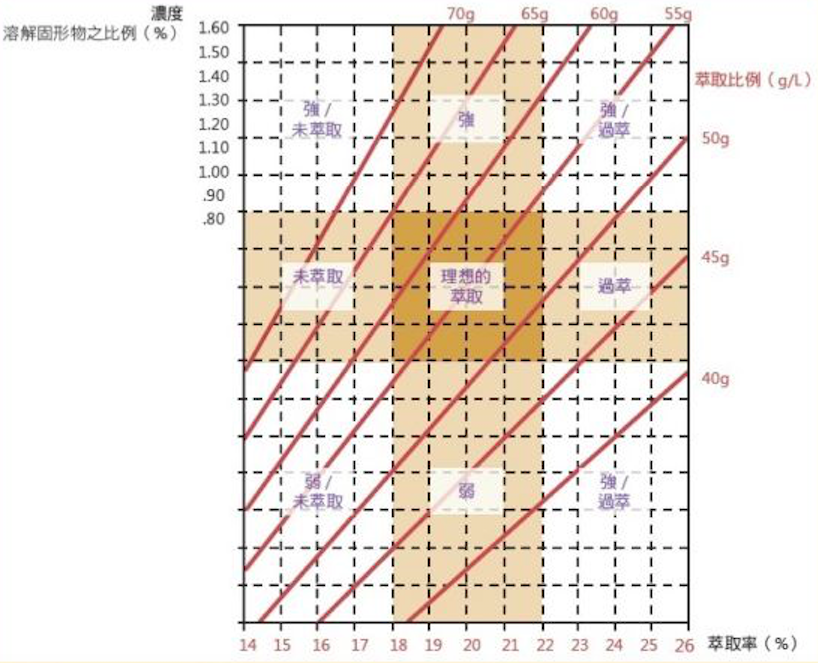
Coffee extraction control chart
Content source: "Coffee staff extreme skills Picture Book"
Important Notice :
前街咖啡 FrontStreet Coffee has moved to new addredd:
FrontStreet Coffee Address: 315,Donghua East Road,GuangZhou
Tel:020 38364473
- Prev
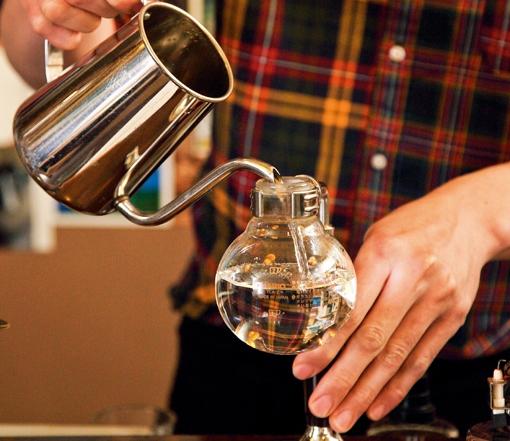
Siphon coffee Syphon pot brewing demonstration, explain what should be paid special attention to
Communication of professional baristas Please pay attention to the Coffee Workshop (Wechat official account cafe_style) although there is no guarantee that the quality of every batch of coffee beans is exactly the same, and the current climatic conditions are uncontrollable, the secret of making a good cup of coffee actually lies in the barista's control over all the details of the procedure. Here, Xiao Yang, the owner of RUFOUS COFFEE, wants to tell you that Yong you
- Next
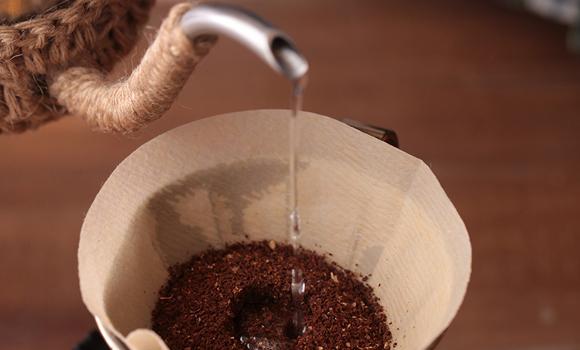
Full mark brewing guide: hand-brewed coffee shows uniqueness and personal style
Professional baristas Please follow the Coffee Workshop (official Wechat account cafe_style) when it comes to coffee beans, they can be divided into light roasting, medium roasting and heavy roasting. Coffee cherries are actually like fruits. Good coffee beans have fruity, floral, cocoa, nutty flavors, etc., usually the lighter the roast and the more sour they are, the more they can drink the essence of the coffee beans; on the contrary, the heavier the roast, the more bitter. Just rush.
Related
- What is the meaning of lactic acid fermentation with coffee bean treatment?
- How to judge the state of foam by sound?
- How does the latte pull out the unicorn pattern? Come to get for a little trick to improve the flower pull!
- Will flower pulling affect the taste of the latte?
- Do you know the history of coffee?
- The difference between honey treatment and sun washing what is raisin honey treatment?
- What kind of milk can a novice use to make coffee foam to keep the foam longer? The correct method and skills of milking tutorial sharing
- Why do washed coffee beans taste sour? Flavor characteristics of washed Coffee
- Introduction to the skill of how to practice the size and height of water injection around the circle of hand-brewed coffee
- How do beginners practice coffee flower drawing from scratch?

